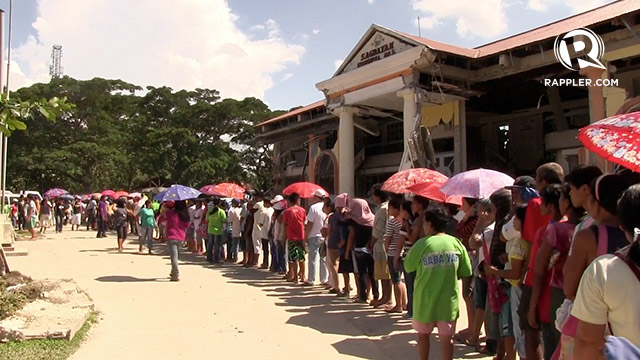SUMMARY
This is AI generated summarization, which may have errors. For context, always refer to the full article.

BOHOL, Philippines – How do you recover from a magnitude 7.2 earthquake?
Residents of Loon, one of the hardest-hit towns in Bohol, say they don’t know where to start.
Voltaire Tupaz reports.
57-year old Antonio Lacien lost his mother and his house to the earthquake. The wake is held in the tent where Antonio, his wife, and his father now live.
ANTONIO LACIER, RESIDENT OF THE TOWN OF LOON: Si Mama nagalingkod sa guwa nya ni kalit la’g linog ba natagakan siya sa hollow block sa balay nya na-bali iyang likod ug nabali iyang tiil. Lisod gyud. Kay pait ang mga tao pag bag-o linog. Tanan tao man nu-on ang naapektahan atong higayon. Naguba ang mga ba’y ba. (Mama was sitting outside when the earthquake suddenly struck. A hollow block fell on her, breaking her back and leg. It is difficult. People have been struggling since the earthquake. Everyone was affected. Houses were destroyed.)
Nearly 64,000 other families across Bohol share Antonio’s dilemma. They live outside their houses in evacuation centers, and in rice fields. Evacuees get soaked when it rains. Many are sick. There are no toilets in many evacuation sites. An ideal evacuation site includes segregated toilets for men and women, bathing cubicles, water supply, a kitchen, and even space for children. The Department of Social Welfare and Development says plans are underway to give decent facilities to victims. It has provided 153 laminated plastic tents and finished constructing its first makeshift hospital.
CONRAD NAVIDAD, INTERNATIONAL ORGANIZATION FOR MIGRATION: Here, you see a typical evacuation center. This is a school ground for those people who cannot return. In here, they will be staying in a camp or a camp-like setting, complete with wash facilities. The requirement for setting up a camp or an evacuation center based on humanitarian standards.
But these new tents are only good for a month. The government is now figuring out how to build more permanent shelters. More than 52,000 houses were damaged.
EDGAR CHATTO, BOHOL GOVERNOR: That is only the initial phase because beyond that, there has to be a temporary but a little bit more sturdy type of housing facilities that they should have.
Rebuilding homes – that’s the next stage. The National Housing Authority is helping people who cannot avail of programs offered by the GSIS, Pag-ibig and SSS. Antonio doesn’t know how, but he says he’ll pick up the pieces after he buries his mother.
ANTONIO LACIER, RESIDENT OF THE TOWN OF LOON: Mangita lang ko’g paagi unsaon pagsulbad ini, magbangon adtong nahitabo ron. Naguba akong ba’y. Maningkamot lang tag asa ta’y ipang-repair kay guba man gyud. ( I’ll find a way to solve this, to recover from what happened. My house was destroyed. I will strive to find the means to repair it because it’s ruined.)
It’s a long road to recovery, between government’s good intentions and actual implementation. And for simple folks like Antonio navigating the bureaucracy is almost as nerve-wracking as an earthquake.
Voltaire Tupaz, Rappler, Bohol. (READ: UN, humanitarian groups help 344,000 homeless in Bohol) – Rappler.com
Add a comment
How does this make you feel?
There are no comments yet. Add your comment to start the conversation.